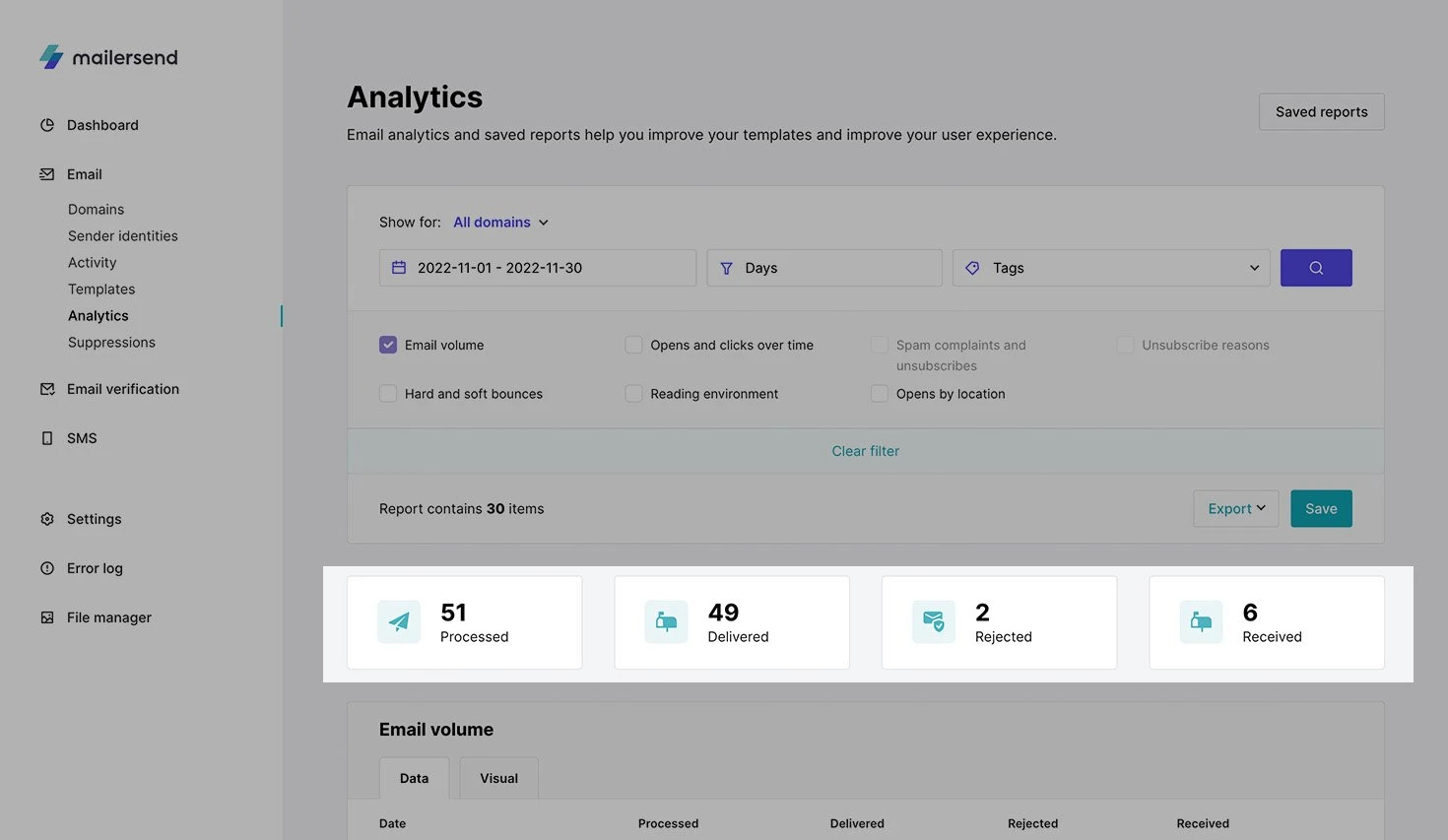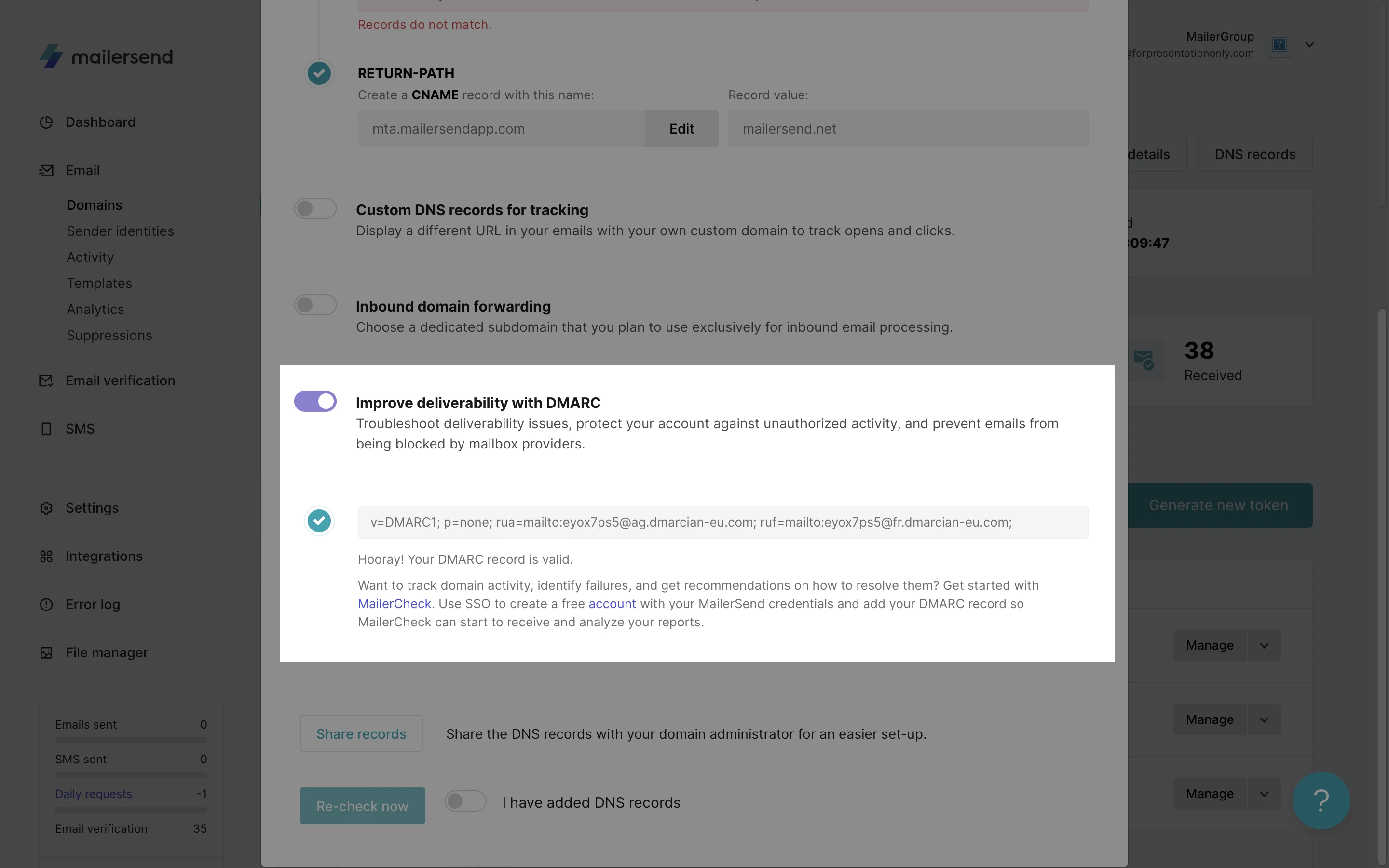How to improve email deliverability
What is email deliverability?
Email deliverability is the ability to deliver emails to recipients’ inboxes. It’s used to determine the chance of email messages reaching your recipients’ inboxes.
Email deliverability rate is the rate at which your emails successfully reach recipients’ inboxes. You can find your email deliverability rate on your Analytics page by taking the number of emails Delivered and dividing it by the number of emails Processed, then multiplying by 100 to learn the percentage.

To determine the deliverability rate of the example above, you would use the following formula: 49/51x100= 96%.
Having a poor deliverability rate likely means that your sender reputation has been damaged by factors such as ISPs, bounces or spam issues.
When it comes to improving and maintaining your sender reputation to improve deliverability, there are two things you need to take into account; the quality of your content and the quality of your email list.
With these best practices for email deliverability, you can optimize both to ensure you hit the inbox every time.
12 best practices to improve deliverability
1. Personalize your emails
Use a personal, recognizable sender address like yourname@yourdomain.com. Then add further personalization to your emails using {{variables}} to show spam filters that you have a relationship with your recipient and that they are expecting your email.
2. Proofread your emails
Misspelled emails and grammatical errors are a distinguishing trait in spammers. Consider running your draft emails through a spell-checker before sending them.
Additionally, writing in ALL CAPS or using multiple question or exclamation marks in a row is not well tolerated by spam filters. Use correct character casing and only use one question or exclamation mark at the end of sentences.
3. Avoid using ‘spammy’ words or phrases
Spam filters scan your emails for certain words and phrases associated with use in cold or fraudulent emails. Avoid spam trigger words phrases like “Please click here”, “Don’t miss this!”, “This is not spam!”, etc.
4. Ditch the red font
Avoid sending emails in red font. Red font has connotations with spam and unsolicited emails, which may cause your emails to be wrongly routed to spam folders.
5. Use images sparingly
Spam filters can’t see images. Instead, they see white space. For this reason, it's not recommended you send your emails as one large image.
Ensure you use text in your emails too, so that spam filters do not assume your email to be blank.
Further to this, when you include images in your emails, be sure to attach ALT text (short for "alternative text") to each image. Spam filters detect this ALT text in place of your images, so if you are using images in your email, using ALT text will help ensure your email reaches the inbox.
6. Refrain from using link shorteners
Spammers like to hide their devious links by using shortened URLs like bit.ly links, so avoid those when possible. Also, double check that you only link to quality sites, particularly if you work with affiliates.
7. Optimize your email footer
Including sender details in your email footer, such as a physical address and a contact telephone number, make your emails look more credible to spam filters.
If you’re sending marketing emails, make sure you have a clearly visible unsubscribe link in your footer as well.
8. Make use of suppression lists
You can use your suppression lists in MailerSend to collect bounces, spam complaints, and unsubscribes. You can also use the custom blocklist to suppress recipients whose email addresses follow specific patterns.
9. Obtain the right permissions
Permissions are not required for all transactional emails; however, if you're sending marketing emails, you need to ensure your recipients have opted-in to receive these communications.
If you're an online store for example, keep in mind that even though a recipient has made a purchase from you in the past and received a transaction email, that doesn’t mean they have given you permission to send them marketing emails without their consent.
10. Validate your recipients list
Using an email validation tool, such as MailerSend's inbuilt email verification feature, enables you to check whether your recipients’ email addresses are valid before you email them and risk damaging your sender reputation with unexpected hard bounces.
This is a great step to take before you contact a recipient for the first time or if you're sending content such as a service notice to recipients you have not contacted for a while.
You can upload your entire email list in the app or use the email verification endpoint to verify your list via MailerSend's API.
11. Utilize reCAPTCHA
Using a reCAPTCHA checkbox and an additional "confirm email address" field upon your recipient initially submitting their information to you will prevent issues with invalid emails caused by typos or bot submissions.
12. DMARC settings
DMARC, which stands for Domain-based Message Authentication, Reporting, and Conformance, is an email-validation system designed to protect your domain from being used for email spoofing, phishing scams, and other cybercrimes. It's particularly relevant and beneficial for domains used to send transactional emails.
DMARC builds on two existing mechanisms, SPF (Sender Policy Framework) and DKIM (DomainKeys Identified Mail). By leveraging SPF and DKIM, DMARC helps prevent bad actors from sending emails that appear to come from your domain. This is crucial for maintaining your domain's reputation and trustworthiness.
A DMARC record is a CNAME record in your domain's DNS. It specifies your DMARC policy and how you want receiving mail servers to report emails that fail SPF and DKIM checks. Domains with DMARC records are often considered more trustworthy by email service providers (ESPs). This is especially important for transactional emails, which often contain important information and need to reliably reach the recipient's inbox.
In MailerSend, follow these steps to check if your domain has a DMARC record present:
Go to Domains.
Click Manage for the domain you wish to check.
Click DNS records.
Scroll down and toggle the option Improve deliverability with DMARC ON.

Test your email deliverability before sending using an email testing tool, like Inbox Insights, that provides a detailed report on how your email will be delivered and what you can do to improve it.
Need more info?
Feel free to reach out to support@mailersend.com. A member of our support team will gladly assist you.
- Getting started
-
FAQ
- How transactional emails work
- How to test email sending in MailerSend
- How to create automations
- How to add a custom unsubscribe header
- How to merge multiple SPF records
- How to verify an email list
- How to whitelist IPs
- How to add a domain space to your account
- How to add a survey to your emails
- How to use the MailerSend iOS app
- How to request a dedicated IP
- SMS: How to handle opt-in and opt-out
- How will the Hobby plan update affect my account?
-
Features
- Analytics
- Custom headers
- Domain tracking options
- Email tagging
- Email and recipient activity
- Ensuring secure SMS communication: Verification and usage limits
- File manager
- Inbound routing
- Managing API tokens
- REST API response codes
- Schedule bulk emails
- Sender identities
- Sending domains
- SMTP relay
- Split Testing
- Templates
- Webhooks
- Upcoming changes to TLS Protocol support
- How to enable Google Email Actions & Highlights
- DMARC monitoring
- Deliverability
- Account settings
- Billing
- Integrations
